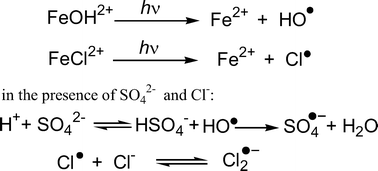Photolysis of ferric ions in the presence of sulfate or chloride ions: implications for the photo-Fenton process†
Abstract
The photo-Fenton process (

- This article is part of the themed collection: In honour of Esther Oliveros
* Corresponding authors
a
Faculdade de Ciências Exatas e Tecnologia, Universidade Federal da Grande Dourados, Mato Grosso do Sul, MS, Brazil
E-mail:
machulekjr@gmail.com
b Universidade Federal de São Paulo, Diadema, SP, Brazil
c
Departamento de Química, Faculdade de Filosofia, Ciências e Letras de Ribeirão Preto, Universidade de São Paulo, Av. dos Bandeirantes 3900, Ribeirão Preto, SP, Brazil
E-mail:
lauokano@usp.br
d Instituto de Química, Universidade de São Paulo, CP 26077, São Paulo, SP, Brazil
The photo-Fenton process (

 Please wait while we load your content...
Something went wrong. Try again?
Please wait while we load your content...
Something went wrong. Try again?
A. Machulek Jr., J. E. F. Moraes, L. T. Okano, C. A. Silvério and F. H. Quina, Photochem. Photobiol. Sci., 2009, 8, 985 DOI: 10.1039/B900553F
To request permission to reproduce material from this article, please go to the Copyright Clearance Center request page.
If you are an author contributing to an RSC publication, you do not need to request permission provided correct acknowledgement is given.
If you are the author of this article, you do not need to request permission to reproduce figures and diagrams provided correct acknowledgement is given. If you want to reproduce the whole article in a third-party publication (excluding your thesis/dissertation for which permission is not required) please go to the Copyright Clearance Center request page.
Read more about how to correctly acknowledge RSC content.
 Fetching data from CrossRef.
Fetching data from CrossRef.
This may take some time to load.
Loading related content
